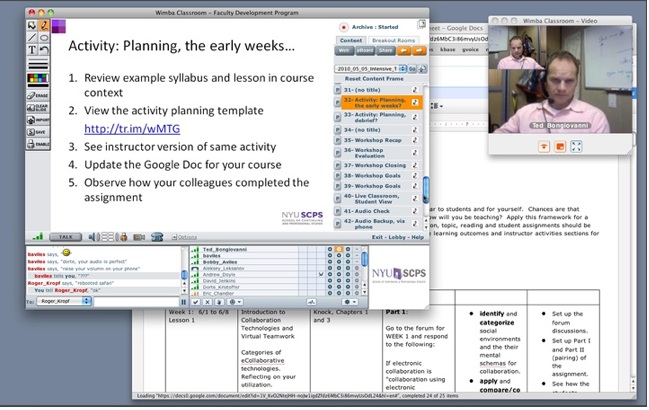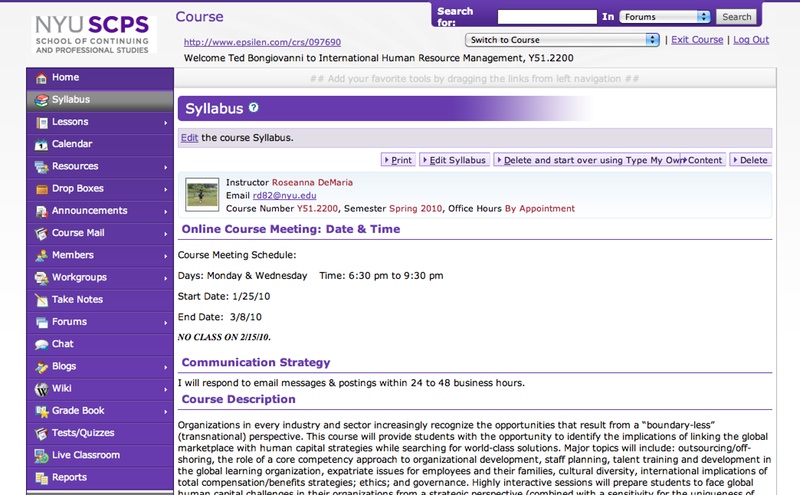Key Takeaways
- Reaching agreement on the convenience of online classes is easy, but arguing in favor of a synchronous learning experience in a virtual classroom is harder.
- Debunking the top 10 myths about synchronous online teaching helps refute the arguments against it, while the transformational nature of online teaching can convert skeptics into supporters.
- With adequate support for their online efforts, would-be online educators can embark on their own synchronous online teaching adventures — and fly!
Come to the edge.
We might fall.
Come to the edge.
It's too high!
COME TO THE EDGE!
And they came
And he pushed
And they flew.
— Christopher Logue
Roseanna DeMaria: Despite the obvious convenience of synchronous online courses, why take the live, on-site, face-to-face experience online? Until I met Ted, an educational technologist in the NYU SCPS Office of Distance Learning, I expected my first online graduate course in International Human Resources Management to be my first and last online teaching experience. Ted's support through that experience transformed my view. Ted is now my thinking partner and chief online learning strategist. Our learning journey took us to unexpected places, and we felt compelled to write this article on the top 10 myths about online teaching to address objections to synchronous online courses. Here we share our journey and will, we hope, convince you to fly with us and become an online educator.
Ted Bongiovanni: We view our work at the NYU SCPS Office of Distance Learning as a collaboration with faculty to transform courses for online teaching. Though we offer a series of workshops to prepare faculty, much of the transformational work takes place in conversations and working sessions. Roseanna and I distilled our thoughts on the process in the article text but also by recording a parallel conversation where we discuss each of the myths. You can download the individual audio files for each section.
Introduction
Podcast: Introduction and Background for Roseanna DeMaria's Move to Online Teaching
Myth 1: Online learning delivers an impersonal learning experience.
Podcast: Myth 1 — Online Learning Is Impersonal
Many educators feel that an online classroom provides an impersonal and limited learning experience, but this viewpoint can apply equally to the in-person classroom experience if the educator is functional, expedient, and antiseptic in delivery. Nonetheless, virtual engagement sounds oxymoronic. Yet, the virtual learning experience has an intensity that can channel a very personal reaction. Students regularly say they rarely participate in their real-world classes the way they do in the online space. They are more confident writing texts and speaking, more willing to take risks in the comfort of their home, and more willing to share personal and professional learning in their blogs because of the venue's familiarity. Even the technological snafus seem to facilitate a pioneering spirit of "we are all in this together."
Similarly, the speed of learning via voice and text chat promotes engagement. Team projects in the virtual classroom include virtual breakout rooms, where students share a whiteboard, texting, audio, and video. Students' virtual breakout room experiences cultivate a concentrated team effort to connect ideas and think harder precisely because they are virtual. They describe a "high definition" learning experience that brings them closer as a learning community. In their blogs they use words like "intimate" and "personal" to describe the experience. This feedback reinforces the notion that the virtual classroom can support a high-impact, personal, and deep learning experience.
Myth 2: They're texting each other, Googling, and Lord knows what else. It's impossible to learn in that environment.
Podcast: Myth 2 — Too Much Going On
In a physical classroom, the instructor doesn't make a habit of inviting students to chat with their neighbors or pass notes. These attractive nuisances interfere with the learning experience because the students become distracted. The virtual classroom has no notes per se, but it does have texts, chats, and other capabilities, which seem distracting. The synchronous online classroom can transform these distractions into learning tools — encouraging text chat and using the instant feedback from students accelerates learning. Figure 1 shows a synchronous online classroom with student activity in progress.

Figure 1. The Live Online Classroom in Action
Most faculty did not grow up texting through life's everyday tasks, unlike Next Gen students, who text both professional and personal messages while multitasking. The experienced educator finds it hard to believe that texting during class can do anything but distract everyone involved. After all, the educator is engaged in teaching and navigating the technology. To expect the instructor to read incoming texts and react to them seems to ask the impossible. Yet, these texts provide clear data points of learning happening in real time, which is invaluable when the instructor can't see the audience. Texting also empowers students who are too shy to participate in oral discussions, providing a safer, more controllable form of communication that also allows developing the reluctant participant in new ways. While students could never talk all at once in a discussion, online they can text in response to those who are talking and add value to the discussion that the speakers can respond to. Ideas develop faster and deeper when the educator manages this learning interaction. Mastering this skill enables instructors to react faster and provide immediate feedback, which results in better learning.
Myth 3: My course is unique. I create a special environment and could not possibly do online what I do in a real classroom.
Podcast: Myth 3 — My Class Is Unique
Online courses offer many tools to the virtual classroom: blogs, discussion forums, wikis, drop boxes, surveys, chat, and workgroup tools, to name a few. Technological issues inevitably accompany each of these tools upon first exposure. Faculty have to understand how they work, how to set them up, how to manage them — and why they are needed.
Considered individually, these tools are nothing more than technological platforms to deliver content in one form or another. In that sense they become tactical ends in themselves, and it is hard to see how they enhance the online learning experience. When considered strategically, however, these tools become compelling learning engines that can both power and support virtual classroom learning. Using them concurrently to develop complementary learning "muscles" enhances their impact for better learning performance across the class. They must be carefully architected in both content and quantity to succeed. For example, a discussion forum can develop skills in advocacy, influence, and analysis. The forum's content should be designed to build on the classroom discussion and blog exchanges, but without becoming redundant. The strategic use of these tools requires substantial planning, design, and tweaking — before the virtual classroom opens — to ensure that students learn.

Figure 2. International Human Resource Management Syllabus Page
Myth 4: Blogs are for navel gazing and gossip; they are not credible learning tools.
Podcast: Myth 4 — Blogs Are for Navel Gazing
Course evaluation surveys at the end of the course are useful tools to measure instructor performance. They ask students to provide feedback on specific topics, as filtered by the survey questions. These surveys do not provide real-time feedback on the quantity and caliber of learning happening in class, however. Blogs, when used as learning journals, can serve this function. A weekly blog entry where the student must apply the week's learning to an existing situation, integrate his or her prior knowledge, and then integrate the learning and applications from week to week during the course provides powerful, real-time insight into the depth and breadth of the student's learning experience and growth. Blogs also facilitate the educator's ability to tailor the following weeks' classes to address gaps or extend the learning further based on the blog's contents.
Certainly this learning journal model could serve the same purpose in the traditional classroom. Because they are online, however, blogs offer a comfortable venue for millennial students. Like texting, the blog encourages creativity. It offers a safe haven that fosters a level of self-introspection and freedom that the written paper journal does not. Consequently, both the learning and the real-time feedback can be more powerful in the online course.
Myth 5: Discussion forums are just another exercise in pushing a string.
Podcast: Myth 5 — Discussion Forums Push on Strings
The discussion forum is arguably the first thing that comes to mind when thinking of online learning. The typical problems are getting students to participate, making sure the comments are substantive, and staying on top of the discussion. When done correctly, discussion forums provide a unique opportunity to expand the classroom learning in two ways:
- A well-constructed forum discussion can set the stage and engage the students prior to class. It provides an opportunity to deliver the initial foundational learning on a particular case or topics that can jump-start the class's exploration of the subject matter.
- The discussion forum can be used after the class session to extend learning.
The discussion forum is not about the number of posts but about idea momentum, where students obsess on ideas and check the forum for posts as obsessively as they e-mail or text. Discussion forums can fuel a level of learning engagement that delivers learning well beyond the perimeters of the classroom experience.
Myth 6: Online group projects are impossible because the "group" is scattered across the Internet and questionable because one or two students can carry the group.
Podcast: Myth 6 — Online Group Projects Are Impossible
Admittedly, virtual group projects sound problematic, but like most aspects of the virtual experience, what looks like a problem is actually a tool the instructor can use to improve the learning experience. Precisely because students are scattered, the virtual breakout room takes on extraordinary immediacy. When students enter a breakout room with a specific assignment requiring them to report back to the entire class in a defined period of time, a sense of learning urgency emerges. They must complete the assignment while navigating their virtual relationships. The assignment and the breakout room venue become a crucible for their development. In a very real sense the students live the learning because their careers in the global business world will demand the same skills — solving a problem with a virtual team while under time pressure. Accountability takes on a new role in this framework. The breakout room group sessions can be archived, providing a performance audit trail. The transparency is obvious in the written contributions of discussion forum posts and wikis. Similarly, the group presentations highlight both participation and silence because of their virtual nature. In the team presentation, virtual teams usually explain who did what and who will be presenting and why. An augmented need for accountability in the virtual venue seems to drive this practice. The "virtuality" can become an enabler when handled adeptly by the educator.
Myth 7: Technological problems will derail my teaching and undermine the student learning experience.
Podcast: Myth 7 — Tech Problems Will Derail Teaching
Self-paced, video-illustrated tutorials and live faculty training sessions, while helpful, do not fully prepare educators for times when the online classroom implodes because of a technological malfunction. The tech failure disrupts learning and takes precious time away from the session. Fortunately, online tools provide avenues for repairing the situation. For example, the instructor can add a post-class discussion forum or blog to facilitate teaching content missed during the interrupted class. In one instance, an online classroom locked several students out, and the help desk was stumped. The locked-out students called their teammates in the classroom for help. Collectively, the students in class conference called their colleagues in on their mobile phones, so they could hear the session and participate by conference call. This solution was one that even the help desk could not provide, but a determined, creative virtual team could. That kind of agility thrives in the virtual space. Technological problems offer teachable moments that can drive innovation and teamwork. They can even become action-learning tools.
Myth 8: You cannot convey passion online.
Podcast: Myth 8 — You Cannot Convey Passion Online
Dedicated educators have all enjoyed the moments when students become so engaged and passionate about learning that no one wants the class to end. These moments demand thoughtful preparation and hard work to successfully execute. The hunger for learning is fierce, and the session is infused with passion. It is hard to believe that these moments can happen in the virtual classroom — but they can, as the following example shows.
DeMaria: My course-operating model is based on the premise that I am the CEO of a consulting firm that specializes in our course subject. My students are my direct reports.
In an attempt to foster a passionate learning experience, I begin each of my virtual classes with a "shock and awe" boardroom roundtable in which I take a topic from our prior class session and ask a question about it that requires students to apply the learning to a new concept. They must answer thoughtfully in no more than three sentences. I am ruthless in demanding a quick, clear answer, and I provide immediate feedback. Any "um," "like," or "I think" is immediately cut off.
In my online International Human Resources Management course, the students' nervousness was palpable. The intensity around this experience grew with each week, and by the final weeks they were executing well. They wrote about their application of the "shock and awe" learning experience in their blogs. They described their accelerating heart rates and their excitement as they met the challenge successfully. This set the tone for each class. They felt that the virtual environment exacerbated the intensity of the exercise because they could never tell who I would call on next, since they could not see any physical movement or eye contact like they would in a physical classroom. They described the intensity of online learning as both passionate and energizing. They are living proof that the virtual classroom can increase heart rates, create performance pressure, and deliver passion.
Myth 9: The virtual classroom can and should be a literal translation of the real-world classroom.
Podcast: Myth 9 — Virtual Classroom as a Literal Translation
NOT! The virtual classroom provides new avenues for learning that require a teaching delivery for that venue. This can be confusing because the online venue provides all the traditional classroom communication tools — voice, video, and its own version of whiteboards, flip charts, overheads, or slides. Simply using these well-established classroom tools to deliver learning online limits instructors' options and ability to engage students. In fact, educators risk becoming disembodied online voices presenting "stuff" — they need to use these tools differently and exploit the virtual qualities of the learning experience. The virtual classroom becomes a safer place for creative risk taking.
The clearest example occurs with the person-to-person visual experience online. The instructor, captured by camera, appears in the confines of a screen, and eye contact with students is not possible. The camera can be a source of discovery, however, enabling a more intense connection. Consider starting an online class focusing on a diversity case study while wearing a mask to initiate a discussion on cultural differences — this can create a powerful connection that frames the session's discussion. Since students can only see part of the instructor in the virtual venue, if what they see is not what they expect, the surprise ignites engagement.
Myth 10: Faculty training focuses on technology tools and educational best practices.
Podcast: Myth 10 — Faculty Training Is About Technology
Training faculty for online teaching is challenging, especially given their concern about losing their classroom "mojo," or confidence. The fear of technological malfunction exacerbates this concern. Naturally, there is a great temptation to train faculty on general pedagogical practices and the online environment's tools, which translates the conventional classroom teaching experience to the online venue. That is why it fails. Although both areas are tactically important for online delivery, they do not address the mojo challenge. Effective faculty training for the online learning experience must be mojo-centric to foster student engagement and deep learning. This requires using the virtual nature of the learning experience to innovate a new brand of educator mojo by exploiting the characteristics of the online venue.
Discovering a new mojo requires faculty openness to living the learning journey. There is no substitute for the actual online classroom experience. Developing technological expertise in operating the virtual classroom helps build confidence in this new venue, but it is not the destination. Educators must experience the online classroom as both learner and instructor in a real-time teaching environment that is relevant and immediate to their needs. The creation of a learning museum for faculty to explore an online course shell and investigate the structure of the course with student work embedded is essential. The availability of archived course sessions that allow faculty to experience the course's virtual classroom in a simulation context is also valuable. In addition, it helps to have faculty "attend" an online class where they can guest lecture and react to students. Similarly, consider a mentoring approach where an experienced online educator audits several sessions and brainstorms improvements with the instructor. Even holding optional pre-course sessions for students to ask questions can enable educators to test drive their online classroom before the course formally begins. Engaged, open, and relentless educators will find their mojo, and then the innovation journey can begin!
Final Thoughts
Enough said. Are you ready to take flight?
What do you think of online teaching and learning? Are you flying? Afraid to get on the plane? An enthusiastic world traveler? Sound off in the comments. We're eager to continue the conversation online.
© 2010 Roseanna DeMaria and Ted Bongiovanni. The text of this article is licensed under the Creative Commons Attribution-Noncommercial-Share Alike 3.0 license.

